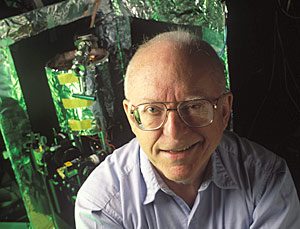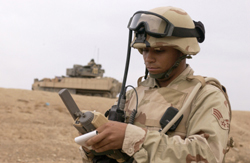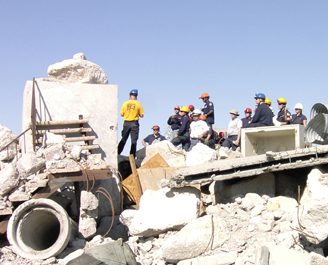| Oct.
7, 2005

[NIST
Tech Beat Search] [Credits] [NIST Tech Beat
Archives] [Media
Contacts] [Subscription Information]

NIST/JILA
Fellow Shares Nobel Prize in Physics
 |
|
Nobel laureate John L.
(Jan) Hall
© 2005
Geoffrey Wheeler
For
a high-resolution version of this photo contact
inquiries@nist.gov. |
On
Oct. 4, John L. (Jan) Hall of the National Institute of Standards
and Technology (NIST) and the University of Colorado at Boulder
and Theodor W. Hänsch of the Max-Planck-Institute of Quantum
Optics, Garching and Ludwig-Maximilians-Universität, Munich,
Germany, were named winners of the 2005 Nobel Prize in Physics,
sharing the honor with Roy J. Glauber of Harvard University.
Hall,
71, is a scientist emeritus in the NIST Quantum Physics Division
and a fellow of JILA, a joint research institution of NIST and
the University of Colorado in Boulder, Colo. He was one of the
founding fellows of JILA (created in 1962 as the Joint Institute
for Laboratory Astrophysics), and he significantly contributed
to the development of the laser, first demonstrated in 1961,
from a laboratory curiosity to one of the fundamental tools
of modern science and a ubiquitous component of modern communications
systems.
Hall is
known as a preeminent laser experimentalist, concentrating on
improving the precision and accuracy with which lasers can produce
a specific, sharp frequency or color of light, and the stability
with which they can hold that frequency. His work has been essential
to the development of the laser as a precision measurement tool.
In the 1960s he worked on the development of the methane-stabilized
helium-neon laser, which became the cornerstone of a famous
experiment at NIST to measure the speed of light at least 100
times better than any previous determination. The work ultimately
led to a fundamental redefinition of the meter, the basic unit
of distance measurement.
Precise
control of the frequency and improved stability have enabled
a broad range of laser applications in science and technology,
including precision spectroscopy for physical and chemical analysis,
new tests and measurements of fundamental physical laws and
constants, time and length metrology, and fiber-optic communications,
among others.
Hall shares
the Nobel Prize with Hänsch "for their contributions
to the development of laser-based precision spectroscopy, including
the optical frequency comb technique.”
For further
information and congratulatory quotes, see www.nist.gov/public_affairs/releases/2005_Nobel_Prize_Hall.htm.

Better
Measurements Reveal Seasonal Changes in Sulfur
Researchers
from the University of Maryland (UMD) and the National Institute
of Standards and Technology (NIST) have developed a new
and improved technique for the simultaneous measurement
of sulfur isotopic ratios and concentrations of atmospheric
sulfate using snow samples from Greenland and Kyrgyzstan.
Sulfur
plays an important role in the Earth’s climate. Sulfate
particles in the atmosphere scatter and absorb sunlight,
provide "seeds" for cloud formation, and affect
the reflectivity and radiance of clouds, and thus the temperatures
at the Earth’s surface. Atmospheric sulfate comes
from natural sources, including oceans and volcanoes, but
a large fraction comes from the burning of fossil fuels.
Researchers can distinguish between various natural and
anthropogenic sources in snow by measuring sulfur isotopes—forms
of the element with different numbers of neutrons.
To
study how these particulates have changed over time, scientists
dig holes in snow that provide an archive of atmospheric
particles deposited on the Earth’s surface. The standard
analysis technique, gas-source isotope ratio mass spectroscopy
(GIRMS), requires relatively large samples—up
to four kilograms (about 9 pounds) of snow and ice, but
the cycling of sulfur in the atmosphere is dynamic and variable,
so samples this large blur seasonal changes.
To
solve this problem, the UMD/NIST team developed a new analytical
tool based on thermal ionization mass spectrometry (TIMS),
which requires much smaller samples. The researchers used
an advanced calibration technique known as double isotopic
spiking to correct measurement drift and obtain isotope
ratio measurements comparable to or better than GIRMS. The
smaller snow samples required for TIMS make it possible
to distinguish seasonal changes in sulfur particulate composition.
The technique also can be used for making highly precise
and accurate measurements of sulfur in low-sulfur fossil
fuels, and similar applications.
The
new technique was presented in a poster* at the 230th National
Meeting of the American Chemical Society (2005). A description
of the technique has been accepted for publication in Rapid
Communications in Mass Spectrometry.
* J.
Mann and W.R. Kelly. Measurement of sulfur isotopic signatures
in two high elevation snow pits. American Chemical Society
Annual Meeting (2005).
Media
Contact:
Michael
Baum, michael.baum@nist.gov,
(301) 975-2763

NIST
Method Improves Reliability of GPS Clocks
 |
|
A
U.S. Air Force staff sergeant acquires Global Positioning
System coordinates.
Photo by S.
A. Cuomo/U.S. Air Force
|
The
average user may not notice, but the Global Positioning System
(GPS) is more reliable today than it was several years ago.
Widely
used by the military, first responders, surveyors and even consumers,
GPS is a navigation and positioning system consisting of ground-based
monitors and a constellation of satellites that rely on atomic
clocks. A statistical method, developed by the National Institute
of Standards and Technology (NIST) and tested and implemented
with the help of several collaborators, has made the job of
analyzing the accuracy and reliability of these satellite-borne
time signals significantly faster and easier. The method will
help ensure that GPS clocks produce accurate location and distance
measurements and remain closely synchronized with official world
time.
The NIST
method, described in a recent paper,* has been incorporated
over the past few years into the GPS clock analysis software
system managed by the Naval Research Laboratory (NRL). The satellite
clocks—commercial devices based in part on research originally
done at NIST—use the natural oscillations of rubidium
atoms as "ticks," or frequency standards. The algorithm
helps detect and correct GPS time and frequency anomalies. The
algorithm also can be used to improve the control of other types
of atomic clocks and has been incorporated into commercial software
and instruments for various timing applications, according to
NIST electronics engineer David Howe, lead author of the paper.
A GPS receiver
pinpoints its location based on the distance to three or more
GPS satellites at known locations in space. The distance is
calculated from the time it takes for satellite radio signals
to travel to the receiver. Thus, timing accuracy affects distance
measurements. The NIST method makes a series of mathematical
calculations to account for numerous measures of random "noise"
fluctuations in clock operation simultaneously. This makes it
easier to estimate many sources of error and identify the onset
of instabilities in the clocks in minutes or hours rather than
days. Adjustments then can be made promptly. The technique also
could accelerate the evaluation of clocks during the process
of building GPS satellites, where test time is at a premium.
"Ultimately, it should improve reliability, stability and
accuracy for many people who use GPS for time and navigation,"said
Howe.
Co-authors
of the paper include scientists from NRL, the Jet Propulsion
Laboratory at the California Institute of Technology, the Observatoire
de Besancon in France, and Hamilton Technical Services in South
Carolina.
* D.A.
Howe, R.L. Beard, C.A. Greenhall, F. Vernotte, W.J. Riley, T.K.
Peppler. Enhancements to GPS operations and clock evaluations
using a "total" hadamard deviation. IEEE Transactions
on Ultrasonics, Ferroelectrics, and Frequency Control.
August 2005.

Simulations
Predict Savings From More Airtight Buildings
U.S.
commercial building owners could save substantially
on annual heating and cooling energy costs by improving
airtightness of their buildings’ envelope,
according to a recent National Institute of Standards
and Technology (NIST) study. The research used simulation
software to evaluate the energy impact of improved
air barriers in three typical non-residential buildings
in five cities, each in a different climate zone.
The results predicted potential annual heating and
cooling energy cost savings as high as 37 percent.
With
baseline energy, climate and building data from
each city, the researchers simulated conditions
of a typical, two-story office building; a one-story
retail building; and a four-story apartment building
in Bismarck, N.D.; Minneapolis, Minn.; St. Louis,
Mo.; Miami, Fla.; and Phoenix, Ariz. Each building
was modeled with wood frame and masonry construction.
Methods for increasing air tightness included building
wraps or coatings for masonry blocks. The study
focused on changes in energy expenditures as a result
of increased airtightness, not on the methods themselves,
so it does not single out a “best” airtightness
method.
For
the frame construction, the combined annual gas-electric
cost savings of improved airtightness would be 33
percent for the hypothetical office building, 21
percent for the retail building, and 31 percent
for the apartment in Bismarck. In Minneapolis, the
predicted savings would be 37 percent, 26 percent
and 33 percent, respectively. In St. Louis, the
numbers would be 37 percent, 24 percent and 31 percent.
Improved
air tightness in the warmer climates would produce
smaller savings but could still be significant in
the long run. In Phoenix, the estimated cost-savings
are 10 percent, 16 percent and 3 percent for the
office, retail and apartment, respectively; and
in Miami, the estimates are 9 percent, 14 percent
and 9 percent.
Predicted
savings for the masonry buildings were similar to
the frame construction. Although not evaluated in
this report, improving building envelope airtightness
also reduces the potential for problems caused by
air leakage such as poor indoor air quality, thermal
comfort and degradation of building materials due
to moisture damage. (Like most commercial buildings,
the buildings in the study used mechanical ventilation
systems to maintain good indoor air quality.)
The
NIST findings are expected to be useful to the American
Society of Heating, Refrigerating and Air-Conditioning
Engineers (ASHRAE), which is currently considering
updating building air leakage requirements in its
non-residential building energy standard 90.1.
Investigation
of the Impact of Commercial Building Envelope Airtightness
on HVAC Energy Use (NISTIR 7238) is available
at http://fire.nist.gov/bfrlpubs/build05/art007.html.
The
research was sponsored by the U.S. Department of
Energy Office of Building Technology.
Media
Contact:
John
Blair, john.blair@nist.gov,
(301) 975-4261


Groups
Join Forces for DHS Rescue Robot Standards
 |
First
responders are briefed on a variety of urban
rescue scenarios. The rubble pile was used
with many different types of search and rescue
robots.
Photo
by Brian Antonishek /NIST
|
At
the recommendation of the National Institute of
Standards and Technology (NIST), the U.S. Department
of Homeland Security (DHS) this month asked ASTM
International to work with NIST and other stakeholders
to develop voluntary consensus standards for urban
search and rescue (US&R) robots. ASTM will disseminate
the final consensus approved standards and test
methods via its Committee E54 on Homeland Security
Applications.
To
assist this effort, NIST engineers, first responders,
technology developers and robot vendors have begun
to examine potential types of standards as well
as tests needed to certify compliance to them. The
comprehensive US&R standards drive, sponsored
by DHS, is aimed at increasing federal, state and
local officials' confidence in the emerging technology,
spurring the purchase and deployment of the potentially
life-saving devices.
Participants
in a series of NIST-hosted workshops to define performance
requirements identified at least 13 different robot
varieties that may be applicable to search and rescue,
from R2D2-type machines that search for victims
within collapsed buildings to aerial ledge landers
and aquatic bottom crawlers. They also counted more
than 100 possible individual performance requirements
in the categories of human-system interaction, logistics,
operating environment, and system components (which
includes chassis, communications, mobility, payload,
power and sensing). Additional requirements are
expected to arise during the standardization process.
The
project Web site lists the robot categories and
specific areas of inquiry at www.isd.mel.nist.gov/US&R_Robot_Standards.
First responders, robot vendors and technology vendors
who have suggestions for technologies to focus on
or promising US&R robots to consider as well
those interested in serving on the ASTM E54 standards
committee, should contact Elena Messina
(301) 975-3235 or usar.robots@nist.gov.
Media
Contact:
John
Blair, john.blair@nist.gov,
(301) 975-4261


Federal
Cryptography Guide Available for Comment
Today,
federal agencies use computer systems and networks
to store information and to interact with industry,
private citizens and other governments both in this
country and around the world. In this increasingly
open environment of interconnected systems and networks,
security is essential to ensure that information remains
confidential, is not modified or destroyed, and is
available when needed. To help federal agencies protect
sensitive, but unclassified information, the National
Institute of Standards and Technology (NIST) has updated
a set of guidelines for selecting and implementing
cryptographic methods.
Originally
published in 1999, Guideline for Implementing
Cryptography in the Federal Government (NIST
Special Publication 800-21) is intended primarily
for federal employees who design computer systems
and procure, install and operate security products
to meet specific needs. NIST is asking for comments
on the publication, which is available at http://csrc.nist.gov/publications/drafts/800-21-Rev1_September2005.pdf (.pdf;
download Acrobat Reader) by Oct. 17, 2005. Send comments
to ebarker@nist.gov, specifying "SP 800-21 Comments"
in the subject field.
The draft
publication is one of a series of key standards and
guidelines produced by NIST’s computer security
experts to help federal agencies improve their information
technology security and comply with the Federal Information
Security Management Act (FISMA) of 2002.
Media
Contact:
Jan
Kosko, janice.kosko@nist.gov,
(301) 975-2767

|

